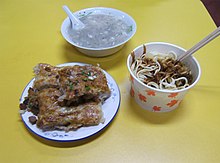Hot dry noodles
This article needs additional citations for verification. (January 2009) |
| Hot dry noodles | |||||||||||
|---|---|---|---|---|---|---|---|---|---|---|---|
 Hot dry noodles (right), Dou pi (left), and Jiuniang (Sweet rice wine). | |||||||||||
| Traditional Chinese | 熱乾麵 | ||||||||||
| Simplified Chinese | 热干面 | ||||||||||
| Literal meaning | hot and dry noodles | ||||||||||
| |||||||||||

Hot dry noodles (Chinese: 热干面 pinyin rè gān miàn), also known as reganmian, is a traditional dish of Wuhan, the capital of the Hubei province in central China.[1] Reganmian has a history in Chinese food culture for 80 years.[2] It is a typical breakfast food in Wuhan, and is often sold in street carts in residential areas.[3] Breakfasts such as Reganmian are available from as early as 5am and are served until midnight (breakfast turns into snacks at night) in Wuhan. The noodle is inexpensive thus remaining as a popular breakfast choice in Wuhan.
The recipe for hot dry noodles is different from cold noodles and noodles in soup. Firstly mix the cooked noodles with oil and dry them. When they are about to be eaten, scald the prepared noodles in boiled water, mix them with condiments, and the noodles will be ready to eat. The finished hot dry noodles are firm and chewy, golden and oily, savory and fresh. It is made of noodles called jianmian (碱面) with a mixture of sauces and dried vegetables. Many stalls that make reganmian will have their own variations in seasoning, creating signature tastes for individual stands or localities.
Reganmian restaurants stand all over the city. The typical bowl of reganmian will have soy sauce, sesame paste, pickled vegetables, chopped garlic chives and chili oil.[4] Reganmian is a popular local breakfast sold in road-side stalls or from push-carts. Reganmian is popular for locals for every season of the year as breakfast, lunch, dinner or just a snack. Wuhan's reganmian, along with Shanxi's daoxiaomian (刀削面: knife-cut noodles), Liangguang's yifumian, Sichuan's dandanmian, and northern China's zhajiangmian, are collectively referred to as "China's five famous noodles." In 2013, Wuhan Reganmian was rated No. 1 in a contest for China's Top 10 famous noodles.[5][6]
Cooking method
Both Wuhan and Szechuan cuisine make extensive use of chiles, to cleanse the palate and to cope with the humid climate.[7] The chef first cooks the fresh noodles mixed with sesame oil in boiling water. When the noodles have cooked and cooled, it becomes pliable. Before eating, the noodles will be cooked in the same process again. Finally, dressings including spring onion and sauce will be added.[8] When preparing reganmian, the noodles are placed into a Chinese strainer (a cone-shaped strainer) and dipped briefly into boiling water and then swirled and drained. The noodles are poured into a paper bowl and the sauce and pickled vegetables are poured on top. Chili oil is used in the seasoning of reganmian as well as a little fresh coriander.
Origin
In the early 1930s, there was a small restaurant operated by Bao Li, who made a living by selling bean noodles and noodle soup near a temple in Hankou. One day, by accident, he spilt sesame oil onto his noodles. The next day, he eventually boiled those noodles and added shallot and other condiments. Next morning, his noodles soon became very popular because of its unique taste. Many people ask Bao Li what kind of noodle it is, Bao Li answered: Hot dry noodles.[9][10]
Variety
In 1933, there are three kinds of reganmian, which are quanliao reganmian, shrimp reganmian, and chashao reganmian. Until in June 1996, there are eight kinds of reganmian, which are quanliao reganmian, shrimp reganmian, chashao reganmian, pork reganmian, zhajiang reganmian, fish reganmian, sanxian reganmian, and fruit reganmian. In 2005, a new kind of reganmian appeared, which is called red oil reganmian. While reganmian is very common in Wuhan, it is difficult to find traditional reganmian outside the city.[3] But during the development and spread of the making technique, Xinyang, a small city near Wuhan, gradually forms its own special way to make reganmian and has got praises and become gradually known to the whole country.[11]
See also
References
- ^ OotTheMonk. (2012, Feb 20). [Web log message]. Retrieved from http://www.instructables.com/id/Hot-and-Dry-Noodles-Re-Gan-Mian-/
- ^ Hubei Tourism Bureau. (2012, 04 21). Hot dry noodles . Retrieved from "Archived copy". Archived from the original on 2012-07-22. Retrieved 2012-11-22.
{{cite web}}: Unknown parameter|deadurl=ignored (|url-status=suggested) (help)CS1 maint: archived copy as title (link) - ^ a b Yu , J. F. (2006, 10 13). [Web log message]. Retrieved from http://wuhanstories.blogspot.ca/2006/10/needless-to-say-hot-dry-noodle-is-most.html
- ^ Hot dry noodles. (2004, 09 03). Retrieved from http://www.cnhubei.com/200408/ca554353.htm
- ^ ""中国十大面条"出炉热干面居首 你吃过几样". 人民网. Archived from the original on 2014-01-17. Retrieved 2013-07-09.
{{cite web}}: Unknown parameter|deadurl=ignored (|url-status=suggested) (help) - ^ "IT'S OFFICIAL: Here Are The Top 10 Kinds Of Chinese Noodles". Business Insider. Retrieved July 9, 2013.
- ^ Parkinson, R. (2012). Hot in hunan. Retrieved from http://chinesefood.about.com/od/regionalchinesecuisine/p/hunan.htm
- ^ Xu, X. (2008). Re gan mian (hot-dry noodles). Retrieved from "Archived copy". Archived from the original on 2012-11-13. Retrieved 2012-11-23.
{{cite web}}: Unknown parameter|deadurl=ignored (|url-status=suggested) (help)CS1 maint: archived copy as title (link) - ^
Anderson, E. N. (1990/09/10). The food of china. (1st ed.). Yale University Press. Retrieved from "Archived copy". Archived from the original on 2012-12-12. Retrieved 2012-11-22.
{{cite web}}: Unknown parameter|deadurl=ignored (|url-status=suggested) (help)CS1 maint: archived copy as title (link) - ^ 湘水散人. (2009, 09 03). Hot dry noodles [Online forum comment]. Retrieved from http://www.3us.com/thread-3991-1-1.html
- ^ "信阳热干面". 新浪网. Retrieved March 3, 2015.
